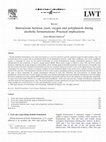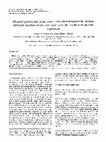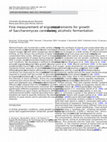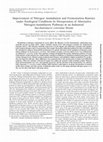Papers by Jean-michel Salmon
ACE, 2008
... Las levaduras activas deshidratadas (LAD) se obtienen industrialmente mediante el secado y gr... more ... Las levaduras activas deshidratadas (LAD) se obtienen industrialmente mediante el secado y granulación de la pasta de las levaduras hasta que los contenidos en agua lleguen a valores del 6 al 8 %. 3 En este estricto paso de secado se induce una reducción del volumen ...

LWT - Food Science and Technology, 2006
During alcoholic fermentation, even when Saccharomyces cerevisiae cells have used the required ox... more During alcoholic fermentation, even when Saccharomyces cerevisiae cells have used the required oxygen for lipid synthesis, they can consume much more oxygen with no detrimental effect on the fermentation process. Under these conditions, most of the superfluous oxygen is consumed by yeasts by the partial functioning of several nonrespiratory oxygen consumption pathways, which are characterized by the production of reactive oxygen species (ROS). When excess oxygen is added to yeast cells, cell sterol content decreases, following the strong oxidation of intracellular sterols. During aging of fermented products in the presence of nonviable yeast lees (harvested at the end of alcoholic fermentation), the lees can consume oxygen for at least 3 years of the aging process. This oxygen consumption by yeast lees is related to moderate oxidation of yeast membrane lipids by the action of free radicals, strongly decreasing sterols in the yeast lees. The biochemical reactions involved in the oxygen consumption pathways during alcoholic fermentation may be the same as those responsible for oxygen consumption observed in yeast lees. Therefore, the cross-reactivity of complex plant polyphenols, tannins and yeast towards oxygen can easily occur during technological processes (alcoholic fermentation and wine aging). The micro-oxygenation of yeasts releases ROS during alcoholic fermentation and may favour the oxidation of wine phenolic compounds. As yeasts have much higher affinities for oxygen than plant polyphenols, viable yeast and yeast lees compete with phenolic compounds and then hinder the wine aging process. Also, the partial adsorption of plant polyphenols on yeast occurs during alcoholic fermentation, which modifies the overall reactivity of yeast and polyphenols towards oxygen.

Journal of Industrial Microbiology, 1994
ABSTRACT Mutants partially resistant to the repressive effect of glucose have been isolated from ... more ABSTRACT Mutants partially resistant to the repressive effect of glucose have been isolated from aSaccharomyces cerevisiae strain totally deficient in phosphoglycerate mutase activity (EC 5.4.2.1) by a selection procedure involving the catabolite-repressive effect of 5-thio-d-glucose (5TG). These mutants are able to resist glucose concentrations up to 15 g L–1 and exhibit several non-repressed metabolic pathways such as gluconeogenesis, glyoxylic shunt or mitochondrial respiratory chain. Moreover, when these mutants are grown in aerobiosis on ethanol and glucose as sole substrates, glucose is mainly converted into glycerol in order to maintain a normal redox balance. Optimal glucose and oxygen concentrations have been defined for resting cells in order to obtain a glycerol yield from glucose close to 100%. The physiological characteristics of one of these mutants led us to consider an application of this yeast strain in reducing the ethanol content of wines previously lowered in ethanol content by physical processes.
Journal of Fermentation and Bioengineering, 1997
We used a heat-induced endomitotic polyploidization procedure to construct an isogenic ploidy ser... more We used a heat-induced endomitotic polyploidization procedure to construct an isogenic ploidy series (2N to 4N) from an industrial strain of Saccharomyces cerevisiae. The nature of the yeast ploidy series observed in this work indicates that the physical and metabolic differences observed among the strains in the yeast ploidy series must be due to differences in gene dosage alone and

Journal of Agricultural and Food Chemistry, 2014
The management of dissolved and headspace gases during bottling and the choice of packaging are b... more The management of dissolved and headspace gases during bottling and the choice of packaging are both key factors for the shelf life of wine. Two kinds of 75 cL polyethylene terephthalate (PET) bottles (with or without recycled PET) were compared to glass bottles filled with a rosé wine, closed with the same screwcaps and stored upright at 20 °C in light or in the dark. Analytical monitoring (aphrometric pressure, headspace volume, O2, N2, CO2, and SO2) was carried out for 372 days. After the consumption of O2 trapped during bottling, the total O2 content in glass bottles remained stable. A substantial decrease of CO2 and SO2 concentration and an increase of O2 concentration were observed in the PET bottles after 6 months because of the considerable gas permeability of monolayer PET. Light accelerated O2 consumption during the early months. Finally, the kinetic monitoring of partial pressures in gas and liquid phases in bottles showed contrasting behavior of O2 and N2 in comparison with CO2.
Communications in Soil Science and Plant Analysis, 1995
ABSTRACT
... Vitigni rari del Piemonte . (Depositato il 27 Settembre 2006); Masi, Fabio . Fitodepurazione ... more ... Vitigni rari del Piemonte . (Depositato il 27 Settembre 2006); Masi, Fabio . Fitodepurazione delle acque . (Depositato il 27 Settembre 2006); Canuti, Valentina e Abrardi, Sara e Siliani, Alessandra e Bertuccioli, Mario e Mosconi, Raffaella e Biondi Bartolini, Alessandra . ...

Applied Microbiology and Biotechnology, 2005
Yeasts can incorporate a wide variety of exogenous sterols under strict anaerobiosis. Yeasts norm... more Yeasts can incorporate a wide variety of exogenous sterols under strict anaerobiosis. Yeasts normally require oxygen for growth when exogenous sterols are limiting, as this favours the synthesis of lipids (sterols and unsaturated fatty acids). Although much is known about the oxygen requirements of yeasts during anaerobic growth, little is known about their exact sterol requirements in such conditions. We developed a method to determine the amount of ergosterol required for the growth of several yeast strains. We found that pre-cultured yeast strains all contained similar amounts of stored sterols, but exhibited different ergosterol assimilation efficiencies in enological conditions [as measured by the ergosterol concentration required to sustain half the number of generations attributed to ergosterol assimilation (P 50 )]. P 50 was correlated with the intensity of sterol synthesis. Active dry yeasts (ADYs) contained less stored sterols than their pre-cultured counterparts and displayed very different ergosterol assimilation efficiencies. We showed that five different batches of the same industrial Saccharomyces cerevisiae ADY exhibited significantly different ergosterol requirements for growth. These differences were mainly attributed to differences in initial sterol reserves. The method described here can therefore be used to quantify indirectly the sterol synthesis abilities of yeast strains and to estimate the size of sterol reserves.
International Symposium on Viticulture and Enology, 1995
... 1984); c) intracellu-lar accumulation of AMP during fermentation (Dombek and Ingram, 1988); d... more ... 1984); c) intracellu-lar accumulation of AMP during fermentation (Dombek and Ingram, 1988); d) sugar trans-port inefficiency (Salmon, 1989). Glucose and fructose uptake has been characterized in laboratory and wine strains of Saccharomyces (McClellan et al., 1989). ...
Applied and environmental microbiology, 1989
Sluggish and stuck (i.e., very delayed or incomplete) fermentations have been often observed in w... more Sluggish and stuck (i.e., very delayed or incomplete) fermentations have been often observed in wine making. Some of them appeared to be associated with insufficient levels of yeast nutrients such as assimilable nitrogen. In these conditions, sugar transport catabolite inactivation, which is triggered by the protein synthesis arrest, may account in part for the inhibition of fermentation. Moreover, this mechanism of inhibition may explain the failure of added ammoniacal nitrogen to nitrogen-limited musts to restore or elevate rate of fermentation after the early yeast growth phase.
Comptes rendus des séances de la Société de biologie et de ses filiales, 1951

Applied and environmental microbiology, 1998
Metabolism of nitrogen compounds by yeasts affects the efficiency of wine fermentation. Ammonium ... more Metabolism of nitrogen compounds by yeasts affects the efficiency of wine fermentation. Ammonium ions, normally present in grape musts, reduce catabolic enzyme levels and transport activities for nonpreferred nitrogen sources. This nitrogen catabolite repression severely impairs the utilization of proline and arginine, both common nitrogen sources in grape juice that require the proline utilization pathway for their assimilation. We attempted to improve fermentation performance by genetic alteration of the regulation of nitrogen-assimilatory pathways in Saccharomyces cerevisiae. One mutant carrying a recessive allele of ure2 was isolated from an industrial S. cerevisiae strain. This mutation strongly deregulated the proline utilization pathway. Fermentation kinetics of this mutant were studied under enological conditions on simulated standard grape juices with various nitrogen levels. Mutant strains produced more biomass and exhibited a higher maximum CO2 production rate than the wi...

Molecular & general genetics : MGG, 1991
A gene encoding pyruvate carboxylase has previously been isolated from Saccharomyces cerevisiae. ... more A gene encoding pyruvate carboxylase has previously been isolated from Saccharomyces cerevisiae. We have isolated a second gene, PYC2, from the same organism also encoding a pyruvate carboxylase. The gene PYC2 is situated on the right arm of chromosome II between the DUR 1, 2 markers and the telomere. We localized the previously isolated gene, which we designate PYC1, to chromosome VII. Disruption of either of the genes did not produce marked changes in the phenotype. However, simultaneous disruption of both genes resulted in inability to grow on glucose as sole carbon source, unless aspartate was added to the medium. This indicates that in wild-type yeast there is no bypass for the reaction catalysed by pyruvate carboxylase. The coding regions of both genes exhibit a homology of 90% at the amino acid level and 85% at the nucleotide level. No appreciable homology was found in the corresponding flanking regions. No differences in the Km values for ATP or pyruvate were observed betwee...










Uploads
Papers by Jean-michel Salmon